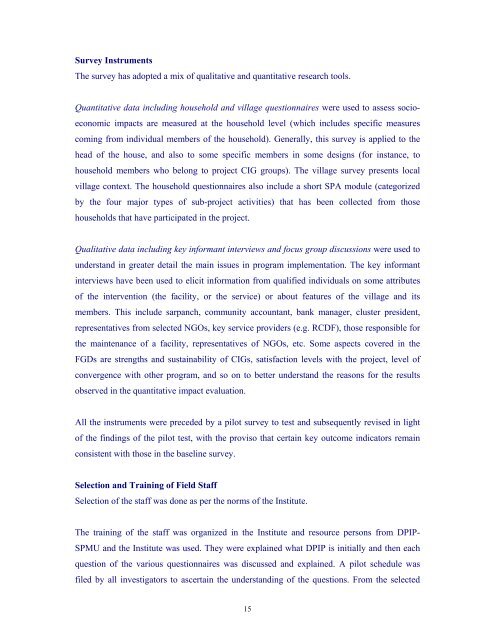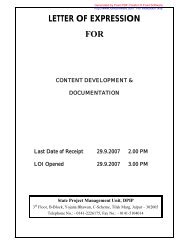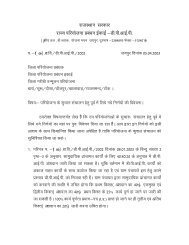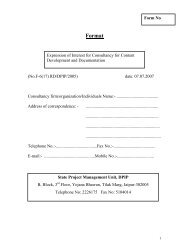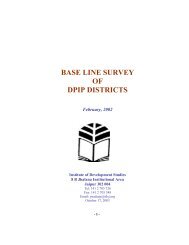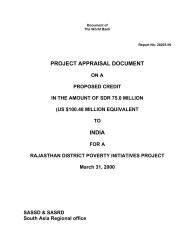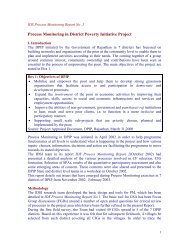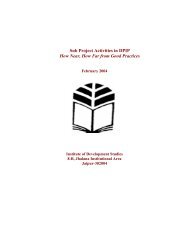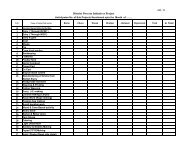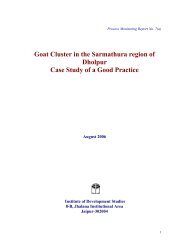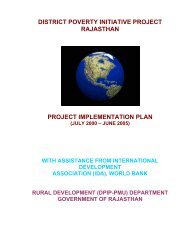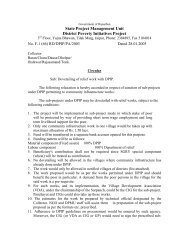Impact Assessment of the District Poverty Initiative Project Rajasthan
Impact Assessment of the District Poverty Initiative Project Rajasthan
Impact Assessment of the District Poverty Initiative Project Rajasthan
Create successful ePaper yourself
Turn your PDF publications into a flip-book with our unique Google optimized e-Paper software.
Survey Instruments<br />
The survey has adopted a mix <strong>of</strong> qualitative and quantitative research tools.<br />
Quantitative data including household and village questionnaires were used to assess socioeconomic<br />
impacts are measured at <strong>the</strong> household level (which includes specific measures<br />
coming from individual members <strong>of</strong> <strong>the</strong> household). Generally, this survey is applied to <strong>the</strong><br />
head <strong>of</strong> <strong>the</strong> house, and also to some specific members in some designs (for instance, to<br />
household members who belong to project CIG groups). The village survey presents local<br />
village context. The household questionnaires also include a short SPA module (categorized<br />
by <strong>the</strong> four major types <strong>of</strong> sub-project activities) that has been collected from those<br />
households that have participated in <strong>the</strong> project.<br />
Qualitative data including key informant interviews and focus group discussions were used to<br />
understand in greater detail <strong>the</strong> main issues in program implementation. The key informant<br />
interviews have been used to elicit information from qualified individuals on some attributes<br />
<strong>of</strong> <strong>the</strong> intervention (<strong>the</strong> facility, or <strong>the</strong> service) or about features <strong>of</strong> <strong>the</strong> village and its<br />
members. This include sarpanch, community accountant, bank manager, cluster president,<br />
representatives from selected NGOs, key service providers (e.g. RCDF), those responsible for<br />
<strong>the</strong> maintenance <strong>of</strong> a facility, representatives <strong>of</strong> NGOs, etc. Some aspects covered in <strong>the</strong><br />
FGDs are strengths and sustainability <strong>of</strong> CIGs, satisfaction levels with <strong>the</strong> project, level <strong>of</strong><br />
convergence with o<strong>the</strong>r program, and so on to better understand <strong>the</strong> reasons for <strong>the</strong> results<br />
observed in <strong>the</strong> quantitative impact evaluation.<br />
All <strong>the</strong> instruments were preceded by a pilot survey to test and subsequently revised in light<br />
<strong>of</strong> <strong>the</strong> findings <strong>of</strong> <strong>the</strong> pilot test, with <strong>the</strong> proviso that certain key outcome indicators remain<br />
consistent with those in <strong>the</strong> baseline survey.<br />
Selection and Training <strong>of</strong> Field Staff<br />
Selection <strong>of</strong> <strong>the</strong> staff was done as per <strong>the</strong> norms <strong>of</strong> <strong>the</strong> Institute.<br />
The training <strong>of</strong> <strong>the</strong> staff was organized in <strong>the</strong> Institute and resource persons from DPIP-<br />
SPMU and <strong>the</strong> Institute was used. They were explained what DPIP is initially and <strong>the</strong>n each<br />
question <strong>of</strong> <strong>the</strong> various questionnaires was discussed and explained. A pilot schedule was<br />
filed by all investigators to ascertain <strong>the</strong> understanding <strong>of</strong> <strong>the</strong> questions. From <strong>the</strong> selected<br />
15


